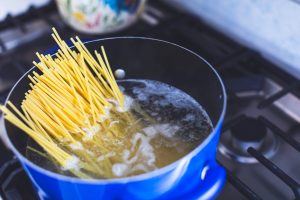Scientists Use Particle Accelerator to Perfect Pasta Cooking
Scientists have used particle accelerators and neutron facilities to uncover the perfect way to cook pasta, revealing why gluten-free alternatives often turn mushy and how salt dramatically affects pasta’s microscopic structure.
Key Takeaways
- Optimal salt level: 7 grams per litre of water
- Cooking time: 10 minutes for regular pasta, 11 minutes for gluten-free
- Gluten acts as a scaffold that maintains pasta structure during cooking
- Gluten-free pasta is more fragile and sensitive to cooking errors
The Science Behind Perfect Pasta
Researchers used the UK’s Diamond Light Source synchrotron and neutron facilities in the UK and France to study how pasta’s internal structure changes during cooking. By scattering X-rays and neutrons off regular and gluten-free spaghetti, they could observe transformations at the atomic level.
The experiments revealed that gluten forms a strong scaffold that holds starch granules in place during boiling, giving regular pasta its firm texture and slow digestion rate. In gluten-free pasta, starch granules swell and collapse more easily, leading to the characteristic mushy texture.
Salt’s Crucial Role
Salt doesn’t just enhance flavor—it significantly impacts pasta’s microstructure. When regular pasta is boiled in salted water (7g per litre), gluten maintains its structure and starch granules suffer less damage during cooking.
However, doubling the salt concentration causes the internal structure to break down rapidly. For gluten-free pasta, even small amounts of salt cannot compensate for the missing gluten protection.
Why Gluten-Free Pasta Fails
Gluten-free pasta is structurally more fragile and less tolerant of cooking errors. Cooking it for just 13 minutes instead of 11, or using very salty water, causes significant degradation. Artificial compounds used to replace gluten degrade quickly under non-optimal conditions.
Future of Food Science
This research demonstrates how cutting-edge tools like neutron scattering—traditionally used for studying magnetic materials and batteries—are transforming food science. The findings will help develop better gluten-free alternatives that are more resilient to cooking variations and closer in texture to regular pasta.
Understanding pasta at microscopic levels helps food scientists identify which ingredients and cooking conditions best recreate gluten’s beneficial structure, potentially improving the glycemic response of gluten-free options.
About the authorAndrea Scotti is a Senior lecturer of Physical Chemistry at Lund University





